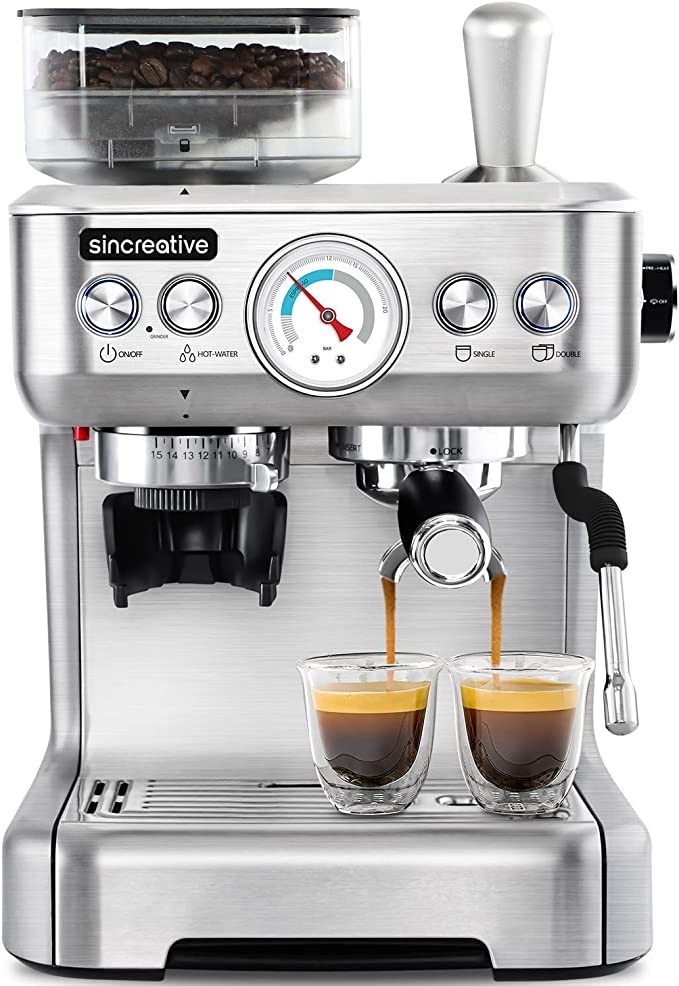De'Longhi Dedica Arte EC885M: Your Compact Gateway to Barista-Quality Espresso
Update on March 25, 2025, 9:31 a.m.
Coffee. That rich, aromatic elixir that fuels our mornings, punctuates our afternoons, and provides a comforting ritual for millions around the world. But for many, the pinnacle of coffee enjoyment lies in the realm of espresso – that intensely flavorful, concentrated brew with its signature layer of golden crema. And while achieving barista-quality espresso at home might seem daunting, the De’Longhi Dedica Arte EC885M makes it surprisingly accessible. This isn’t just a coffee machine; it’s a gateway to understanding and mastering the art and science of espresso.

The Science of Extraction: Pressure, Temperature, and Time
Before we delve into the specifics of the Dedica Arte, let’s explore the fundamental principles behind espresso extraction. Think of it as a carefully orchestrated symphony of three key elements: pressure, temperature, and time.
Why 9 Bar is the Magic Number. Unlike drip coffee, which relies on gravity, espresso relies on pressure to force hot water through finely-ground coffee. The ideal pressure for espresso extraction is around 9 bars (about 130 psi), significantly higher than atmospheric pressure. This intense pressure is crucial for several reasons. First, it extracts the desirable oils and soluble compounds from the coffee grounds, resulting in a concentrated and flavorful brew. Second, it creates the crema, that hallmark layer of golden-brown foam that sits atop a well-pulled shot. Crema is formed by the emulsification of coffee oils and the release of carbon dioxide (CO2) trapped within the beans during roasting. The De’Longhi Dedica Arte boasts a 15-bar pump, but it’s important to clarify that this is the maximum pump pressure. The machine is internally regulated to deliver the optimal 9 bars during extraction.
Thermoblock Technology: Heat on Demand. Just as important as pressure is temperature. Water that’s too cool will under-extract the coffee, resulting in a sour, weak shot. Water that’s too hot will over-extract, leading to a bitter, burnt taste. The ideal brewing temperature for espresso is between 195°F and 205°F (90°C - 96°C). The Dedica Arte utilizes a thermoblock heating system. Unlike traditional boiler systems, which heat a large reservoir of water, a thermoblock heats water on demand as it flows through a compact, aluminum block with embedded stainless steel tubing. This offers several advantages: rapid heat-up time (around 40 seconds), energy efficiency, and consistent temperature control.
The Golden Rule of Extraction Time. The final piece of the puzzle is time. The ideal extraction time for a standard double shot of espresso is typically between 25 and 30 seconds. This timeframe allows for the optimal balance of flavors to be extracted from the coffee grounds. Too short, and you’ll get an under-extracted, sour shot. Too long, and you’ll end up with an over-extracted, bitter one.

Dedica Arte: Your Compact Espresso Maestro
The Dedica Arte EC885M embodies De’Longhi’s commitment to quality and innovation. It’s a remarkably compact machine, measuring just under 6 inches wide, making it perfect for kitchens where counter space is at a premium. But don’t let its small size fool you – this machine packs a serious punch.
Unboxing and First Impressions: Out of the box, the Dedica Arte exudes a sense of understated elegance. The stainless steel finish (or the alternative color options) is both stylish and durable. The controls are simple and intuitive: three illuminated buttons for single espresso, double espresso, and steam, along with a steam knob on the side. The water tank, located at the rear, is easily removable for filling and cleaning.
Key Features Deep Dive:
-
15-Bar Pump and Optimal Pressure: As discussed earlier, the 15-bar pump provides the necessary power to achieve the ideal 9-bar extraction pressure, ensuring a rich and flavorful espresso with a beautiful crema.
-
My LatteArt Steam Wand: From Silky Smooth to Frothy Delight: This is where the Dedica Arte truly shines. The redesigned steam wand, dubbed “My LatteArt,” provides exceptional control over milk frothing. Unlike the “panarello” style wands found on some entry-level machines (including previous Dedica models), which inject a lot of air automatically, the My LatteArt wand allows for more manual control, enabling you to create a range of textures, from the velvety smooth microfoam perfect for latte art to a more voluminous froth for cappuccinos. This is achieved through a combination of steam pressure and the careful positioning of the wand tip in the milk. The underlying principle at play is Bernoulli’s principle: the fast-moving steam creates a low-pressure zone, drawing in air and creating bubbles The key is to introduce just enough air to create microfoam – tiny, uniform bubbles that give the milk a silky, velvety texture. This texture is essential not only for latte art but also for the overall mouthfeel and integration of milk and espresso in your drink. Larger, less uniform bubbles create a frothy, quickly dissipating foam, while microfoam creates a stable, sweet, and creamy texture that blends seamlessly with the espresso.
-
Volumetric Dosing: Precision at Your Fingertips: One of the standout features of the Dedica Arte is its programmable volumetric dosing. This allows you to customize the amount of water used for each shot, ensuring consistent results every time. Out of the box the default is a time based dose. By holding down the single or double espresso button, you can program the machine to dispense your desired volume of espresso. The machine remembers this setting, so you don’t have to manually stop the shot each time. This eliminates guesswork and ensures that you’re always pulling the perfect shot, tailored to your specific coffee beans and taste preferences.
-
Temperature Setting:
The machine’s temperature setting, controlled through a simple button sequence (as detailed in the user manual), allows for customization to suit individual taste preferences and bean types. -
Auto Shut-Off:
To enhance energy efficiency and safety, the Dedica Arte features an auto-shutoff function, and it’s programmable! -
The E.S.E. Pod Option: Convenience at Your Fingertips: For those days when you’re short on time or simply prefer the convenience of pre-packaged coffee, the Dedica Arte is also compatible with Easy Serving Espresso (E.S.E.) pods. These pods are pre-portioned, pre-tamped servings of coffee enclosed in a paper filter. While they may not offer the same level of control and freshness as freshly ground beans, E.S.E. pods provide a convenient and mess-free alternative. The Dedica Arte includes a dedicated filter basket for E.S.E. pods.
-
Maintenance
Regular maintenance is also a breeze. The removable drip tray, cup tray, and water tank are easily cleaned with warm, soapy water. The steam wand should be wiped clean after each use and purged with steam to prevent milk residue buildup. The machine also features a descaling indicator light, which alerts you when it’s time to remove mineral deposits that can accumulate over time.
Mastering Milk: The Art of Microfoam
Creating beautifully textured milk is as much a science as it is an art. Let’s break down the process:
The Science of Steaming: Denaturing Proteins and Creating Texture. Milk contains proteins, primarily casein and whey. When you introduce steam into cold milk, these proteins begin to denature, or unfold. This unfolding allows them to trap air, forming bubbles. The heat from the steam also helps to stabilize these bubbles, creating a stable foam. The fat content of the milk also plays a role, contributing to the richness and mouthfeel of the foam. Whole milk generally produces the best microfoam due to its higher fat content.
Step-by-Step Milk Frothing Guide:
- Start with Cold Milk: Use cold milk straight from the refrigerator. The colder the milk, the more time you have to texture it before it reaches the ideal temperature.
- Purge the Steam Wand: Before steaming, briefly turn on the steam wand to purge any condensation.
- Position the Wand: Place the steam wand tip just below the surface of the milk, slightly off-center.
- Introduce Air (Stretching Phase): Turn the steam knob fully on. You should hear a hissing sound as air is incorporated into the milk. This is the “stretching” phase, where you’re increasing the volume of the milk.
- Create a Whirlpool (Texturing Phase): Once you’ve increased the volume by about 20-50%, lower the steam wand tip slightly deeper into the milk. This will create a whirlpool, or vortex, which helps to break down larger bubbles into microfoam.
- Monitor Temperature: Continue steaming until the milk reaches the desired temperature (around 140-160°F or 60-70°C). You can use a thermometer, or gauge the temperature by touch – the pitcher should be hot but not too hot to hold.
- Tap and Swirl: Once you’ve finished steaming, tap the pitcher on the counter to remove any large bubbles and swirl the milk to create a glossy, paint-like consistency.
- Pour and Enjoy: Pour the milk immediately into your espresso, creating latte art if desired.
- Clean:After frothing, use a damp cloth to immediatly clean the wand.
Latte Art Basics: From Simple Hearts to Elegant Rosettas. Latte art is the beautiful, decorative designs created on the surface of espresso drinks using textured milk. While it takes practice, even beginners can achieve impressive results with the Dedica Arte’s My LatteArt steam wand. Start with simple designs, like a heart or a monk’s head, and gradually work your way up to more complex patterns like rosettas and tulips. The key is to have properly textured milk with a smooth, velvety microfoam.
Beyond the Basics: Elevating Your Espresso Game
Once you’ve mastered the fundamentals of espresso extraction and milk frothing, you can start experimenting with different variables to fine-tune your coffee to your exact preferences.
Choosing the Right Beans: Arabica vs. Robusta, Roast Levels. The type of coffee beans you use will have a significant impact on the flavor of your espresso. Arabica beans are generally considered to be higher quality, with a smoother, more aromatic flavor profile. Robusta beans are more bitter and have a higher caffeine content. The roast level also plays a crucial role. Lighter roasts tend to be more acidic and have brighter, more nuanced flavors, while darker roasts are bolder, more bitter, and have a more pronounced “roasty” flavor.
The Importance of Grind Size: Finding the Sweet Spot. The grind size is arguably the most critical variable in espresso extraction. For espresso, you need a fine grind – finer than table salt but coarser than flour. The correct grind size ensures that the water flows through the coffee grounds at the optimal rate, extracting the desired flavors without over-extracting or under-extracting. A burr grinder is highly recommended, as it produces a more consistent grind than a blade grinder.
Tamping Techniques: Achieving Consistent Results. Tamping is the process of compressing the ground coffee into a firm, even puck. This creates resistance, forcing the water to flow evenly through the coffee and extract the flavors properly. Aim for a tamping pressure of around 30 pounds, using a level and consistent motion.
Troubleshooting Common Espresso Problems:
- Sour Espresso: This usually indicates under-extraction. Try grinding finer, increasing the dose, or increasing the extraction time.
- Bitter Espresso: This usually indicates over-extraction. Try grinding coarser, decreasing the dose, or decreasing the extraction time.
- Weak Espresso: This could be due to a variety of factors, including stale beans, too coarse a grind, too low a dose, or too low a brewing temperature.
- No Crema: This could be due to stale beans, too coarse a grind, too low a brewing pressure, or too low a brewing temperature.

Conclusion: The Joy of the Home Barista Experience
The De’Longhi Dedica Arte EC885M is more than just a coffee machine; it’s an invitation to explore the fascinating world of espresso. It’s a tool that empowers you to become your own barista, to experiment with different variables, and to create coffee that is perfectly tailored to your taste. The journey from novice to confident home barista is a rewarding one, filled with the satisfaction of mastering a new skill and the daily pleasure of enjoying truly exceptional coffee. So, embrace the art of espresso, and let the Dedica Arte be your guide.







































